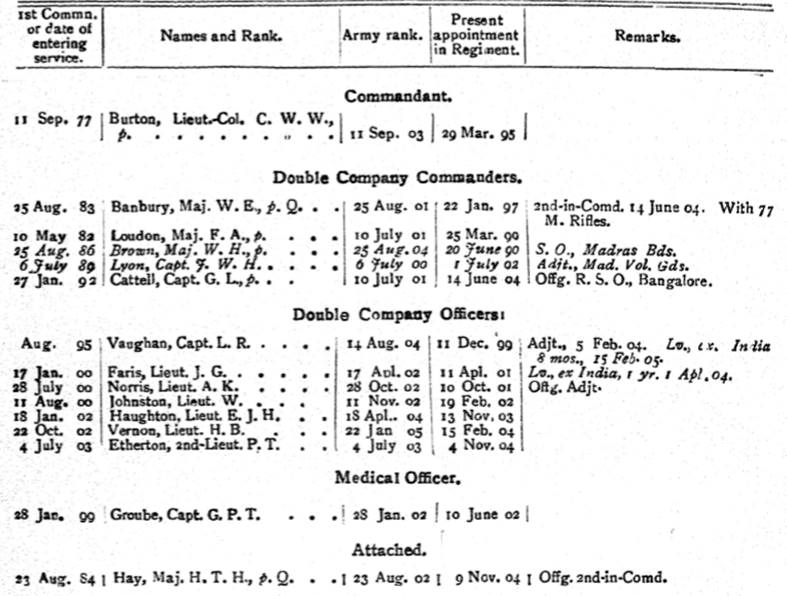This article looks at the final years of the 78th Moplah Rifles, an Indian infantry regiment which was disbanded in 1907. The Regiment will be of interest to anyone looking at the Indian Army’s martial race theory. This article is one of my guides to researching those who served in the Indian Army War and additional guides can be viewed by clicking on the link below:
The 78th Moplah Rifles
Lineage: The Regiment was raised at Trichinopoly by Captain W. Kenny in 1794 as the 35th Battalion of Madras Native Infantry. In 1798 the Regiment became the 1st Battalion, 13th Regiment of Madras Native Infantry and then the 25th Regiment of Madras Infantry in 1885. Then in 1902 the Regiment became the 2nd Battalion Moplah Rifles and was redesignated as the 78th Moplah Rifles in 1903. The Regiment was disbanded in 1907.
Class Composition of the Regiment: 8 Companies of Moplahs.
The 78th Moplahs was an Indian infantry regiment which was disbanded prior to the outbreak of the First World War due to poor reports. The Regiment was recruited solely from Moplahs (Mappilas), a Muslim community which was located on the Malabar Coast in southern India. The Regiment was never highly regarded and makes an interesting case study for anyone interested in the martial race theory.
In 1906 the 78th Moplahs was stationed at St. Thomas’ Mount, Madras (Chennai, Tamil Nadu, India) where it had arrived from Bangalore on 12 December 1901. The surviving confidential reports for the Regiment make interesting reading and are very critical. In their 1905-06 report, Lieutenant-General Sir Bindon Blood reported, “My opinion of this Battalion is that it should be disbanded as soon as possible”. While in their 1906-07 report, General A Hunter, Commanding Western Command wrote: “Evidently a hopelessly inefficient set of creatures”. Below is an extract from a Despatch from the Government in India responding to a question asked in the British Parliament in regards to the disbandment of the two Moplah battalions:
9. The Moplahs are descendants of Arab traders and Malabar women, and a race of Musalmans from which it was hoped good soldiers might be recruited. Owing to their fanaticism, however, the Madras Government raised strong objections to Moplah battalions being employed continuously for local garrison purposes, and it became evident that unless they could be used as part of the field army, they would be of little military value.
It was therefore decided to move the 78th Moplah Rifles to Dera Ismail Khan, a station in the Derajat-with a view to giving them some experience of the frontier, and affording them facilities for training under conditions approximating to those which would obtain on active service. Complete lines, which had been occupied for years by Punjab troops, awaited them on arrival. Snow is unknown in Dera Ismail Khan. After three months’ trial it became evident that the men were unable to stand the dry climate of the Punjab Frontier, and the regiment was removed to Ahmednagar.
Extract Paragraph 9 of an (Army) Despatch from the Government of India, No. 56, Dated 28 June 1906. Indian Army Reorganisation IOR/L/MIL/7/7143.
The strength of the 78th Moplahs in early 1907 was approximately 350 men and it was disbanded later in the year. The extract below was taken from the April 1905 Indian Army List and recorded the British officers serving with the Regiment.
Sources of Information for the 78th Moplahs
There’s a good deal of information concerning the 78th Moplahs and its disbandment in 1907. The Confidential Reports on Regiments etc. of the Regiment which are held at the British Library are detailed and also contain the annual confidential reports of the British officers who served with the Regiment. Information regarding the British and Indian officers who served with the 78th Moplahs can be found by consulting the Indian Army List.
There is also a file on the questions asked in parliament regarding the two Moplah battalion which is held at the British Library: Moplah Battalions: Parliamentary Questions IOR/L/MIL/7/7143. A recruiting handbook was also produced for the Moplahs and can also be found at the British Library: Recruiting Handbooks for the Indian Army: Mappillas or Moplahs by Major Pomeroy Holland-Pryor. Calcutta: Govt of India, 1904. IOR/L/MIL/17/5/2163.

